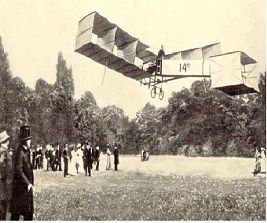<< airborne weather radar | aircraft | aircraft accident >>
Back to: "A"
aircraft
- Definição1
- Any structure, vehicle, or machine designed to travel through air supported by its own buoyancy or by the action of air on its surface. It includes airplanes, gliders, helicopters, and balloons. It does not include hovercraft, which obtain their lift from the reaction of air against the earth's surface. ICAO defines aircraft as "any machine that can derive support in the atmosphere from the reaction of the air against the earth's surface". Aircraft has also been defined as "device(s) that are used or intended to be used for flight in the air, and when used in air traffic control terminology, may include the flight crew" ("AIM, FAA).
- Fonte1
- KUMAR, Bharat (ed.). An illustrated dictionary of aviation. New York: McGraw-Hill, c2005. 752 p.
- Definição2
- A device that is used, or intended to be used, for flight.
- Fonte2
- FEDERAL AVIATION ADMINISTRATION. Pilot's handbook of aeronautical knowledge. [s.l.], 2008. Disponível em: http://www.faa.gov/regulations_policies/handbooks_manuals/aviation/pilot_handbook/media/PHAK%20-%20Cover-Preface.pdf. Acesso em: 26 jun. 2014.
- Fonte3
- INTERNATIONAL CIVIL AVIATION ORGANIZATION. Manual on Volcanic Ash, Radioactive Material and Toxic Chemical Clouds. Third edition. Montreal, 2015. (Doc. 9691).
- Nota adicional1
- Acronym in English: ACFT.
- Nota linguística
- Aircraft has no plural form
- Contexto
- This means that the effect of toxic gases in the cockpit could be the immediate incapacitation of the flight crew and the loss of the aircraft and passengers.
- Subárea
- Aviation
- Related Term
- airplane
- airship
- balloon
- fighter
- fixed-wing aircraft
- glider
- human-powered aircraft
- seaplane
- two-engine aircraft
- Narrower Term
- heavier-than-air aircraft
- light-sport aircraft
- lighter-than-air aircraft
- military aircraft
- passenger aircraft
- unmanned aircraft
- Spanish
- aeronave
- Imagem

Primer vuelo de la aeronave 14 Bis de Santos-Dumont, Campo de Bagatelle - Paris, 23 de octubre de 1906.
Fonte: BRASIL. Comando da Aeronáutica. Departamento de Controle do Espaço Aéreo. DCA 1-1: doutrina básica da força aérea brasileira. Rio de Janeiro, 2012.

